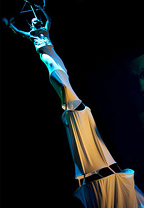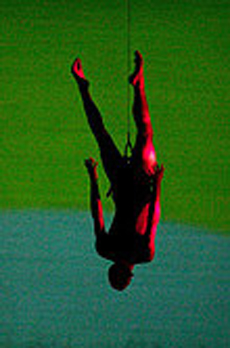
DANCE: Insight: Choreographer Jodi Lomask, on "Digging in the Dark"
"Digging In the Dark" is about probing the layers of the Earth as a metaphor for probing the human mind and heart.
It is dark down there, it is dark in there. We search dark places for artifacts we can bring back or out.
I was interested in exploring how we relate to the Earth and the ways we get to know each other and ourselves.
The show takes its structure from the layers of the Earth, from the atmosphere, to the crust, the mantle, the outer core, the inner core, and back again.
We talked a lot in the Capacitor Lab process about what modern scientists know and don't know about the layers of the Earth and what many of them think lies below as much of what scientists think is in there is unproven.
We used these descriptions to create movement, as well as metaphors.
For example, many scientists believe that the inner core of the earth is crystalline. So I created a quartet of performers binding together in a crystalline fashion...with angles and symmetrical lines.
When the economy was booming and Y2K was approaching, culture's energy was expansive -- people were looking up and out. That is when we created "Within Outer Spaces", about Earth's relationship to outer space.
Now that people have less money, we have been involved in a war in which oil has played a large role, we are feeling uncertain about our future as a global community, culture's energy is contracting.
We are feeling the costs -- people are wanting to go in and down, to find out what really matters and are re-examining what is really necessary.

[Shown above: "Digging in the Dark"]
SCIENCE VS. ART
I grew up around a lot of scientists and artists, so in a way, we tend to make work from what is familiar to us.
I think that the childlike curiosity you need in order to make great scientific discovery is similar to the curiosity you need to make great art. You need to want to get into things, you need to wonder how they work.
I think art and science at their best are hard to distinguish, but I am not sure that I would call them the same thing.
INPUT/OUTPUT
Recently, I've been reading "A Land in Motion, California's San Andreas Fault" by Michael Collier. I've been using "Seismic Data Processing, Theory and Practice" by L. Hatton/M. Worthington/J. Makin to gain exposure to modern mapping technology.
I really enjoyed "Earth: Portrait of a Planet" by Stephen Marshak, with contributions from Donald Prothero.
I've been watching documentaries on earthquakes, volcanoes, and the earth's interior as well.
I am exposing myself to these sources of 'brain beef' searching for elements of excitement; for example, that a great earthquake can result in a sudden increase of gravity which makes the body feel like it weighs five hundred pounds. This idea is something I find fascinating as a dancer, as a motion artist, as a person whose job it is to feel deeply.
INTERSECTION
This was an email I received after our beta test of "Digging In the Dark":
"I'm a geophysicist at UC Berkeley and saw [excerpts from] "Digging in the Dark" last year. I was thoroughly impressed! It should be required for all geology students."
Other scientists came to the beta test and filled out questionnaires that I could dig up later. In general, scientists who are involved in the creative aspects of their field find a lot to relate to in our shows.
Their minds are open and they are not precious about the subject matter. They're pleased to see people engaging with it in a new way, offering other folks a portal into their world.
PROGRESSION
I hope "Digging in the Dark" is more refined [compared to prior works]. This is my goal -- to make the work more and more clear, more honest, more pure.
I have always had a lot of great ideas and refining them is where I need to focus.
CORE MEANING
The core philosophical theme in the work, essentially, is that a small change on the deeper layers can result in huge consequences on the surface.
Four inches of annual motion in the mantle results in the entire continental shift we experience on the surface, which means all of the earthquakes, volcanoes, mountain building, and flash floods.
A small adjustment to one's perspective on a deep enough level can change the course of one's life and all of the elements within it.
"Digging in the Dark" explores the nature of stability, vulnerability, change, memory and the human need to make the invisible visible.
[Comparisons can be drawn between] scientific principles of stability, vulnerability to stressors, necessary change, and the same principles, and experiences, in human nature.
About this group: ca-pac-i-tor: n. a device for accumulating and holding a charge of electricity.
Capacitor is a San Francisco-based performance group that creates multidisciplinary performances through intensive collaborations and in-depth dialogue with a community of artists and individuals from widely varying fields of study.
Capacitor's mission is to explore science and technology as a portal for delving deeper into human nature and as a means for creating a new lexicon of images and movement collages that reflect shifts in the contemporary world.
To cultivate new and relevant performance concepts, Capacitor developed the Capacitor Lab, a think-tank of artists engineers, scientists and philosophers who exchange ideas, share knowledge, and ignite each other's imaginations, spurring the creation of innovative performance pieces.
About this artist: Jodi Lomask founded Capacitor in 1997, with the idea of exploring non-traditional combinations of arts and sciences through movement. Since that time, Lomask has directed and choreographed five full-evening performance pieces including "Within Outer Spaces", "Avatars" and "Digging in the Dark". Her choreography has been produced at the Cowell Theater, ODC Theater, Dancer's Group, Somarts Gallery, and Alice Arts Theater and has toured internationally.
Lomask trained at the Royal Ballet Academy, Merce Cunningham Studio and the Rotterdam Dansacademie. She has performed with Project Bandaloop, Kneejerk, Erica Essner, and Capacitor.
[Shown/header image: "Digging in the Dark"
Photo credits: Edgar Lee]
Read more artist profiles in the June 2004 issue of "Arte Six".

<< Home